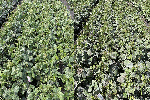Australia’s $93 billion primary production sector is protected from biological threats by a biosecurity system that requires constant vigilance to ever-evolving risks. Innovation that enhances diagnostic and detection capability is essential to ensure the system stays fit for purpose over time.
Recently, a five-year project helped to boost Australia’s level of protection within plant production sectors by delivering gains to monitoring, diagnostic and operational capability.
While these innovations have taken place behind the scenes, a summary of what has been achieved is available in a report entitled Boosting diagnostic capacity for plant production industries.
Included are the grain, cotton, sugar, horticulture, viticulture and forestry sectors. The project was framed around high-priority exotic pest species that are not yet present in Australia but pose a high incursion risk. Examples relevant to the grains sector include the khapra beetle (Trogoderma granarium) and cyst nematodes (Heterodera).
This work was undertaken as an Australian Government Rural R&D For Profit project that ran from April 2019 to June 2023. The funds were administered by GRDC, which led a consortium of research and development corporations, industry bodies and government agencies in a range of research, capacity-building and extension projects.
A focus on diagnostics
The report’s authors point out that, as a rule, “the speed with which a pest or disease incursion can be detected, contained and eradicated is directly related to how quickly the threat can be identified”.
That lifts diagnostic tests, skills and operational processes to the forefront of biosecurity innovation efforts.
A review in 2018 found considerable variation across Australia’s diagnostic resources, which include testing protocols, reference specimens, image libraries, human capability and in-field procedures.
The latest project sought to close these gaps by leveraging the latest technology to improve the speed and precision with which outbreaks are identified, traced and managed. This includes diagnostic capacity building, such as training; exotic pest identification workshops; building surge capacity for high-priority pests; enabling faster diagnosis by reducing bottlenecks and boosting capacity.
It also includes enhanced diagnostic tools, such as early indicators for high-priority plant pests; improvements to critical reference collections; improving national diagnostic protocols for high-priority plant pests; and determining the geographical origin of pest incursions to better inform trade decisions for high-priority plant pests; and determining the geographical origin of pest incursions to better inform trade decisions.
The Boosting diagnostic capacity for plantproduction industries report details how a focus on diagnostic tests, skills and operational processes is important for biosecurity innovation efforts.
Examples include sequencing the genomes of potential bacterial threats to provide a rapid and definitive basis for species identification.
Extension efforts were also undertaken to ensure plant pathologists and diagnosticians are familiar with the new tests and information resources.
This included in-field detection, sampling and diagnostic ‘blitz’ exercises for producers and on-the-ground personnel to increase awareness of high-priority plant pests and testing protocols.
The extension activities were broad-ranging and included the production of fact sheets for use by growers to help them identify and respond to insect pests in their crops.
As the report highlights: “Having the right capability in the right hands – and in the right place – is the key to detecting, containing and eradicating any exotic high-priority plant pest.”

Activities within a project to boost Australia’s biosecurity defences included diagnostic testing blitzes, extension and training workshops that targeted the khapra beetle. Photo: QDAF
Impacts for the grain sector
The grain sector is among the beneficiaries of the biosecurity-related development work through:
- the development of pest identification resources for industry stakeholders;
- exploring the use of environmental DNA (eDNA) diagnostics to identify and track high-priority pests in the field;
- identifying and prioritising risks and developing commensurate diagnostic protocols;
- training workshops, including ‘Pest Blitz’ simulation exercises;
- whole genome sequencing that captured the diversity in Australian Fusarium oxysporum species and the development of high-throughput diagnostic tests for subspecies of this important soil-borne pathogen;
- developing expertise in nematode identification, along with new testing methods to reduce reliance on the skill and availability of individual specialists;
- producing an extensive collection of morphological specimens and genetic material for both local and exotic cyst nematodes;
- building surge capacity for industry surveillance, in-field triage and high-throughput testing during a high-priority pest incident;
- determining the geographic origin of priority insect pest detections to inform biosecurity and risk mitigation protocols, and also provide a scientific basis for declarations of continued area freedom and for market access;
- developing affordable, field-deployable screening tests for exotic viruses;
- the development of high-throughput diagnostics for border surveillance and field screening of exotic cyst nematodes – this included molecular assays and updates to the Waite Insect and Nematode Collection at the University of Adelaide;
- the development of a database to improve diagnostics for khapra beetle using DNS sequencing and validation of existing assays;
- diagnostic testing blitzes targeting khapra beetle alongside extension and training workshops for consultants, growers and on-the-ground biosecurity personnel; and
- the development of education resources and the delivery of workshops and in-field activities to support faster and more accurate identification of exotic pests, disease management, grower engagement and the implementation of new diagnostic protocols.
More information: Callum Fletcher, callum.fletcher@grdc.com.au
Follow-up information for growers, advisers and diagnosticians
State grains biosecurity officer contacts
New South Wales: Kate Glastonbury, 0417 687 307, kate.glastonbury@dpi.nsw.gov.au
South Australia: Jordan Scott, 0437 723 295, jordan.scott@sa.gov.au
Western Australia: Jeff Russell, 0447 851 801, jeff.russell@dpird.wa.gov.au
Victoria: Jim Moran, 0418 377 930, jim.moran@agriculture.vic.gov.au
Queensland: Dr Adam Jalaludin, 0429 727 690, adam.jalaludin@daf.qld.gov.au
Resources: The National Plant Biosecurity Diagnostic Network (NPBDN) includes fact sheets for major horticultural pests.
Further reading:
GroundCover story - Investment in diagnostics pays dividends for grain growers
GRDC Publication - Boosting diagnostic capacity for plant production industries.

























































